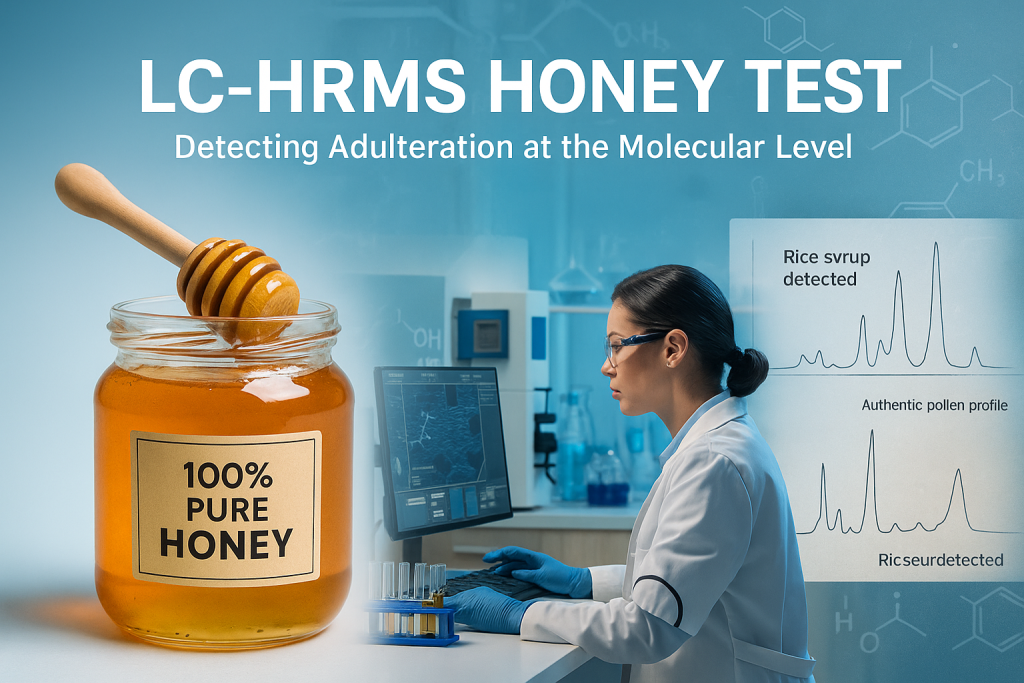The LC-HRMS honey test is one of the most powerful tools available today to detect adulteration in honey. As honey fraud becomes more sophisticated, this advanced testing method ensures purity with unmatched precision.
____________________________________________________________________________________________________________________________________________________________________________
What is LC-HRMS?
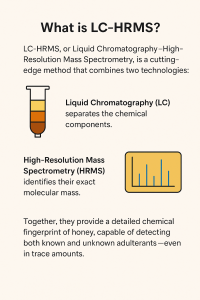
LC-HRMS, or Liquid Chromatography–High-Resolution Mass Spectrometry, is a cutting-edge method that combines two technologies:
- Liquid Chromatography (LC) separates the chemical components.
- High-Resolution Mass Spectrometry (HRMS) identifies their exact molecular mass.
Together, they provide a detailed chemical fingerprint of honey, capable of detecting both known and unknown adulterants—even in trace amounts.
____________________________________________________________________________________________________________________________________________________________________________
How the LC-HRMS Honey Test Works
First, the honey is dissolved in a liquid solvent. This solution passes through the LC system, which separates the components based on their properties, such as size and polarity. These separated compounds then enter the mass spectrometer, where HRMS identifies their mass-to-charge ratio. The result is a detailed profile of the honey’s chemical composition.
____________________________________________________________________________________________________________________________________________________________________________
Why the LC-HRMS Honey Test Matters in Adulteration Detection
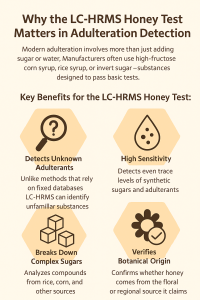
Modern adulteration involves more than just adding sugar or water. Manufacturers often use high-fructose corn syrup, rice syrup, or invert sugar—substances designed to pass basic tests.
Key Benefits of the LC-HRMS Honey Test:
- Detects Unknown Adulterants: Unlike methods that rely on fixed databases, LC-HRMS can identify unfamiliar substances.
- High Sensitivity: Detects even trace levels of synthetic sugars and adulterants.
- Breaks Down Complex Sugars: Analyzes compounds from rice, corn, and other sources.
- Verifies Botanical Origin: Confirms whether honey comes from the floral or regional source it claims.
____________________________________________________________________________________________________________________________________________________________________________
Top Strengths of the LC-HRMS Honey Test
- High Accuracy: Provides a comprehensive breakdown of chemical composition.
- Wide Detection Range: Catches a broad spectrum of synthetic additives.
- Dynamic Adaptability: Works well against new adulteration techniques.
____________________________________________________________________________________________________________________________________________________________________________
Limitations of the LC-HRMS Honey Test
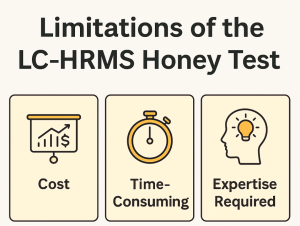
Despite its strengths, this test does come with a few challenges:
- Cost: Requires expensive equipment and trained personnel.
- Time-Consuming: Sample prep and analysis take longer than basic tests.
- Expertise Required: Interpretation demands a skilled analyst.
____________________________________________________________________________________________________________________________________________________________________________
How the LC-HRMS Honey Test Compares with NMR
Another widely respected method is NMR (Nuclear Magnetic Resonance). While NMR provides a broad profile to verify authenticity and geographic origin, LC-HRMS excels in identifying specific adulterants.
| Feature | LC-HRMS | NMR |
|---|---|---|
| Detects unknown adulterants | ✅ Excellent | ⚠️ Limited |
| Botanical origin analysis | ✅ Good | ✅ Excellent |
| Detail level | ✅ High molecular precision | ✅ Broad spectrum |
| Accessibility | ⚠️ Expensive, needs experts | ⚠️ Also expensive, limited access |
For the most robust honey testing, both LC-HRMS and NMR are often used together.
____________________________________________________________________________________________________________________________________________________________________________
Where is LC-HRMS Used?
The LC-HRMS honey test is being adopted by regulatory agencies, premium honey brands, and international labs in Europe, North America, and India. In countries where honey fraud is common, LC-HRMS has become a preferred method for confirming purity and quality.
____________________________________________________________________________________________________________________________________________________________________________
Conclusion
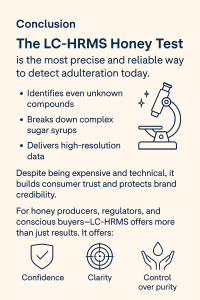
The LC-HRMS honey test is the most precise and reliable way to detect adulteration today. Its ability to identify even unknown compounds, break down complex sugar syrups, and deliver high-resolution data makes it essential for brands and labs serious about honey authenticity.
Despite being expensive and technical, it builds consumer trust and protects brand credibility.
For honey producers, regulators, and conscious buyers—LC-HRMS offers more than just results. It offers confidence, clarity, and control over purity.
Go to Complete list of laboratory tests to ensure purity and quality of honey

